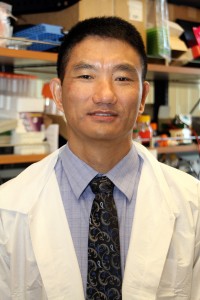Keck Discovers Critical Factor of Viral Cancer
Researchers at Keck School of Medicine have discovered a critical factor of viral cancer —causing component in the virus responsible for Kaposi’s sarcoma, the most prevalent type of cancer for HIV-infected individuals.
The study was led by S.J. Gao, professor of microbiology and immunology at the Keck School of Medicine, in collaboration with colleagues at University of Texas at San Antonio and University of Texas Health Science Center.

Science Guy · Shou-Jiang Gao and his colleagues were able to identify the microRNA molecules that cause normal cells to become cancerous.
Photo courtesy of Jon Nalick
Until recently, it was difficult to study the link between Kaposi’s sarcoma-associated herpesvirus and Kaposi’s sarcoma, because experimental cells that were infected with the virus died before they could become malignant cancer cells. Gao and his colleagues developed a new line of cells from rat stem models, which lived to become malignant cancer cells.
“I have been working in this area since the virus was discovered in 1994, and I was one of the earliest investigators and everybody has been working hard the last two decades because there were no models,” Gao said. “In 2012, we were able to develop a primary cell that had not been used before and we were able to demonstrate cancer using those cells.”
Gao continued to explain the particular characteristics of these cancer cells.
“There are [a] number of standard assays in the cancer field to test,” Gao said. “One of the hallmarks of cancer cells is the loss of contact inhibition. You can mimic this characteristic in vitro, where the cancer cells do not show contact inhibition, and when you put those cells in an animal, they become cancerous.”
Using these newly developed cells, the team identified the microRNA molecules that cause healthy cells to become cancerous. They showed that when these molecules were kept from functioning, the cells did not turn into cancer cells. When they were turned on the cells became cancerous.
Gao emphasized, however, that these microRNA molecules were just one of many factors that produce Kaposi’s sarcoma. Further work is necessary to identify the others.
“The microRNA is required for the process but is not sufficient by itself,” he said. “In cancer cells, there are many changes that need to happen [for healthy cells to become cancer cells]. What we have done is to identify one of those changes.”
This discovery comes as good news to individuals with compromised immune systems, as they are the most susceptible to Kaposi’s sarcoma. In areas with high HIV-infection rates, as much as 90 percent of the population shows signs of Kaposi’s sarcoma.
Gao highlighted the possible benefits of his discovery, but explained that it would take time for the discovery to be used in a drug.
“We know what is required for this cancer to occur, at least one of the them. From the therapeutic perspective, if you could, for example, inhibit the microRNA, you could theoretically stop the cancer,” he said. “This is a very early stage and we are doing basic work, so there is still a long way to go, but there is still that potential.”
Students appeared interested in the promising nature of this new discovery.
“Although this research isn’t complete, it is a promising development for combating KHSV and possibly cancer in general,” said Vance Lindolm, a junior majoring in computer science and business.
Rick Yang, a junior majoring public policy and development, echoed this statement.
“This research looks promising. I wonder how long it will take scientists to utilize this research into creating drugs or a vaccination to combat cancer.”
Jung-Gi Min, a junior majoring in biology and gerontology, thought the results of the study were interesting because of the virus’ unique system of infection.
“It makes a lot of sense that the virus would develop creative processes to enhance its survivability,” he said. “In this case, it is really interesting to see the virus using such a unique mechanism of host propagation through the utilization of miRNA.”
